DEI budgets and headcount are up, but only 30% of HR leaders strongly agree DEI programs are safe if times gets tougher
At the end of 2022, with a recession lurking around the corner and companies looking for areas to make deep spending cuts, corporate diversity, equity, and inclusion (DEI) programs emerged as a top candidate for the chopping block. After years of growth, it seemed like DEI programs would begin their decline in 2023.
According to Capterra's 2023 DEI Cutbacks Survey, that hasn't happened.* In fact, the HR leaders in our survey tell us their DEI programs are flourishing. A majority say their DEI budget increased in 2023 and that their company is prioritizing DEI even more this year than they have in the past.
Partly thanks to an economy that hasn't declined as expected, DEI programs are safe for now. That being said, HR leaders aren't completely confident that their programs are safe if times get tougher. Ultimately, there's still work that needs to be done to convince executive decision-makers that DEI programs should be spared from cutbacks when a major downturn actually happens.
/ Key findings
Most employers haven't cut back on DEI: Only 8% of HR leaders at companies with a dedicated DEI budget say that budget has been reduced in 2023.
Companies are spending more on DEI training and software: A majority (69%) say their company is investing more money in both DEI training and DEI software this year than it did in 2022.
The end of affirmative action is having an effect: 86% agree that the Supreme Court's recent decision banning affirmative action in college admission decisions puts more pressure on employers to improve DEI.
Despite all this, DEI programs aren't totally safe: Only 30% strongly agree that their company's leadership recognizes DEI as a core pillar of their talent strategy that can't be sacrificed in tough times.
Why DEI is not just surviving, but thriving
The speculation about DEI cutbacks this year had merit. Multiple reports and studies at the end of last year hinted at a pessimistic outlook for corporate DEI programs entering 2023:
A report by Bloomberg found that notable tech companies such as Amazon, Meta, and X (formerly Twitter) laid off multiple DEI employees last year. Bloomberg also cited research from Textio, which found that the number of global DEI job openings declined 19% from January to December last year. By comparison, HR job listings as a whole only declined 13%.[1]
Following steady increases every year since 2017, Glassdoor found that the number of job reviews in the U.S. indicating access to a diversity program stalled out in 2022.[2]
We expected to see similar results in our own data when we asked 445 HR leaders about how their company is investing in and prioritizing DEI in 2023. Instead, we found the opposite.
Of the HR leaders in our sample that have a dedicated budget for DEI initiatives, only 8% say that budget was reduced this year compared to 2022. A majority (65%) say their budget actually increased.
Our numbers are less rosy in regards to DEI headcount, but still show overall growth. At companies with roles dedicated to DEI, 23% say their number of roles was reduced this year, 44% say it stayed the same, and 33% say it increased.
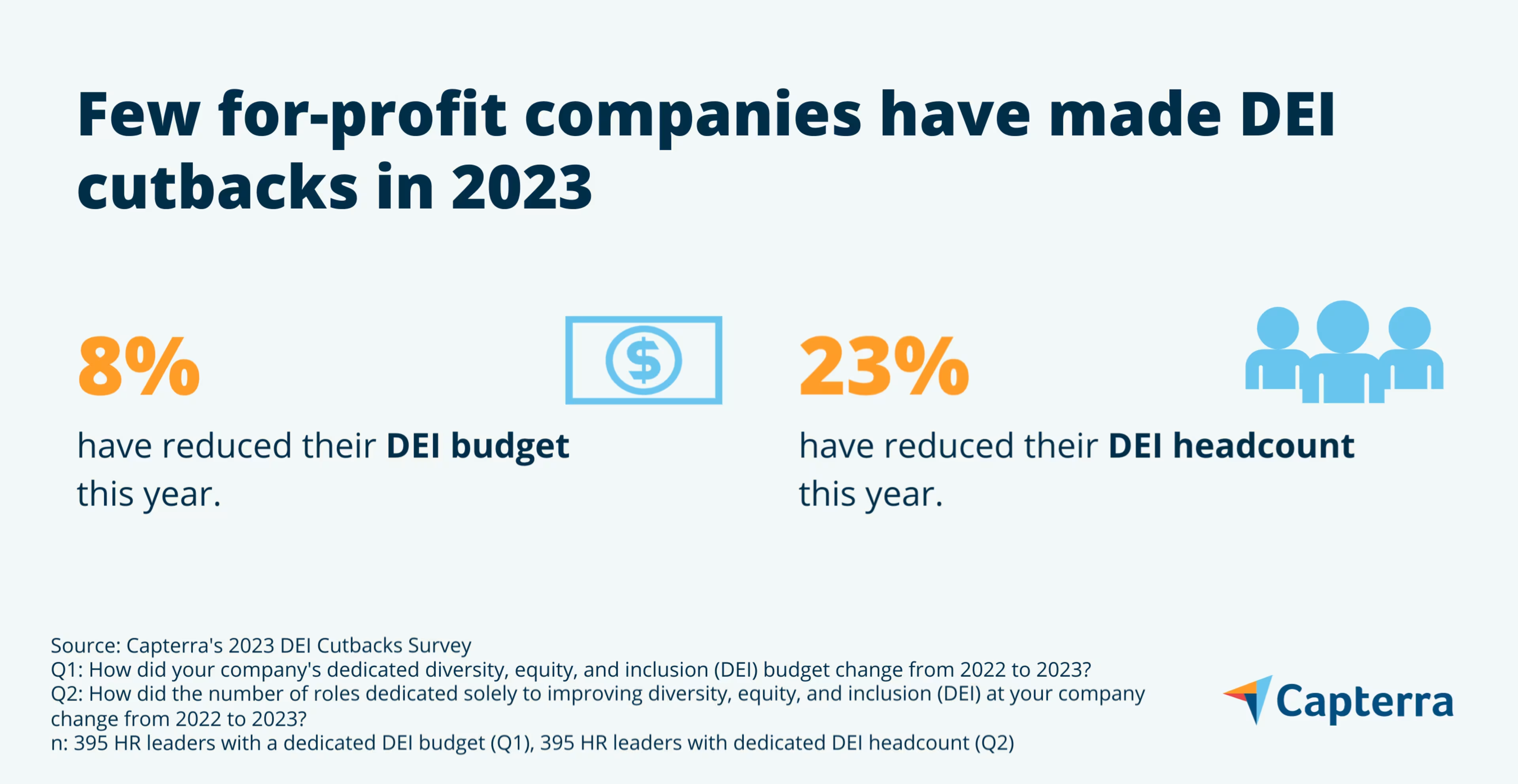
If there is one type of company where the narrative around DEI cutbacks somewhat applies, it's midsize businesses with between 101 and 1,000 employees. This was the size of business in our survey most likely to reduce its DEI budget (18%) and headcount (33%) this year. That being said, a majority still maintained or increased their DEI investment in these areas.
So, why are companies defying expectations and continuing to invest in DEI in 2023? We have a few theories:
The economy hasn’t collapsed as expected: In October 2022, economists pegged the likelihood of a recession in the next 12 months at 65%. By August 2023, that number was 40% and trending downward.[3] A combination of cooling inflation, a rebound in consumer confidence, and a resilient job market has companies feeling better about their financial outlook this year, motivating them to continue investing in their talent management priorities. Our own data supports this, as two in three HR leaders (67%) say their company is projected to have more revenue this year than it did in 2022.
The biggest DEI reductions are happening in the public sector: The mass DEI layoffs reported at some tech companies last year didn't ripple across other private industries. In fact, the most significant DEI cuts are set to take place in the public sector, where large state employers such as Texas and Florida passed legislation to eliminate DEI programs at public colleges and universities.[4]
Workers have made it known that DEI is important: In an April survey, 78% of employees said they would not consider working for a company that fails to commit significant resources to prioritizing DEI initiatives.[5] In the same survey, 87% said they would feel more loyal to a company with a track record of prioritizing DEI. Employers risk serious retention problems when they reduce their investment in DEI.
The Supreme Court’s decision on affirmative action puts more pressure on employers: In June of this year, the U.S. Supreme Court ruled against the use of race-conscious admission decisions at colleges and universities. With higher education losing a mechanism to deliberately make their graduate body more diverse, the HR leaders in our survey say more responsibility now rests on them to find and hire diverse candidates when these graduates enter the job market.
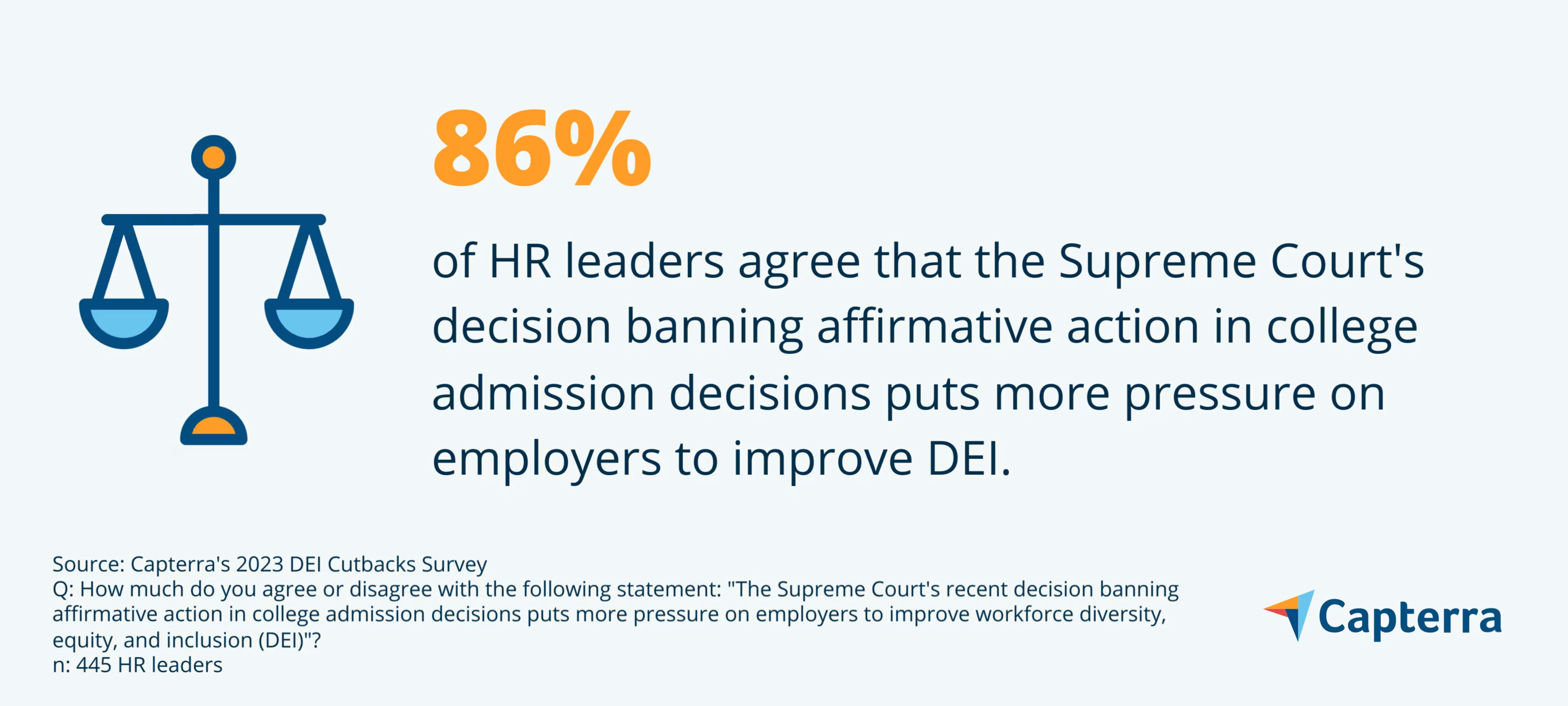
We find that the confluence of these factors is motivating companies to not just maintain their prioritization of DEI in 2023, but increase it. Overall, 58% of HR leaders in our survey say their company is prioritizing DEI more in 2023 than they have in year's past, 32% are prioritizing DEI about the same, and only 10% are prioritizing DEI less.
DEI training and software see widespread boosts in spending
With more budget at their disposal, HR leaders tell us they've increased their spending on a number of initiatives this year to improve diversity, equity, and inclusion at their organization.
Sixty-nine percent of respondents say they're investing more money in both DEI training and software this year than they did in 2022, while 67% say they're investing more in dedicated DEI headcount and diversity recruiting resources each. Of the six DEI initiatives we asked respondents about, none had a majority spending the same or less than they did last year—proving that the increased prioritization of DEI this year isn’t just talk.
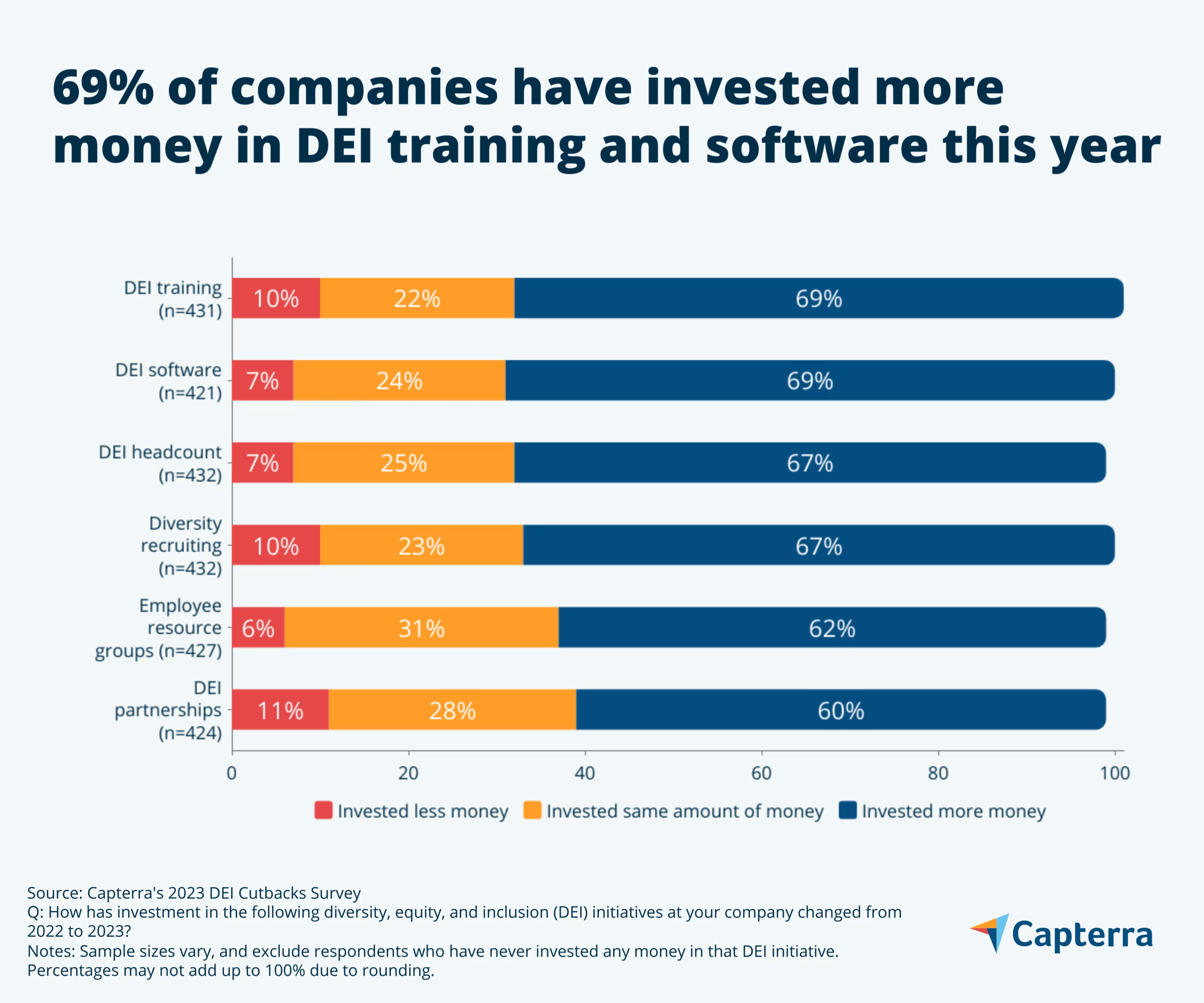
DEI software, specifically—whether it’s a dedicated DEI tool or a DEI feature set found in a more comprehensive talent management suite—has proven to be a valuable "Swiss Army knife" investment for HR departments striving to make progress on a variety of DEI goals.
Of the 96% of HR leaders who have dedicated DEI software or HR software with DEI features, a majority say they use their software to administer DEI training modules (55%), track progress towards DEI goals (50%), or manage employee resource groups (50%). But many also use their software to get feedback on their DEI programs or report DEI metrics.
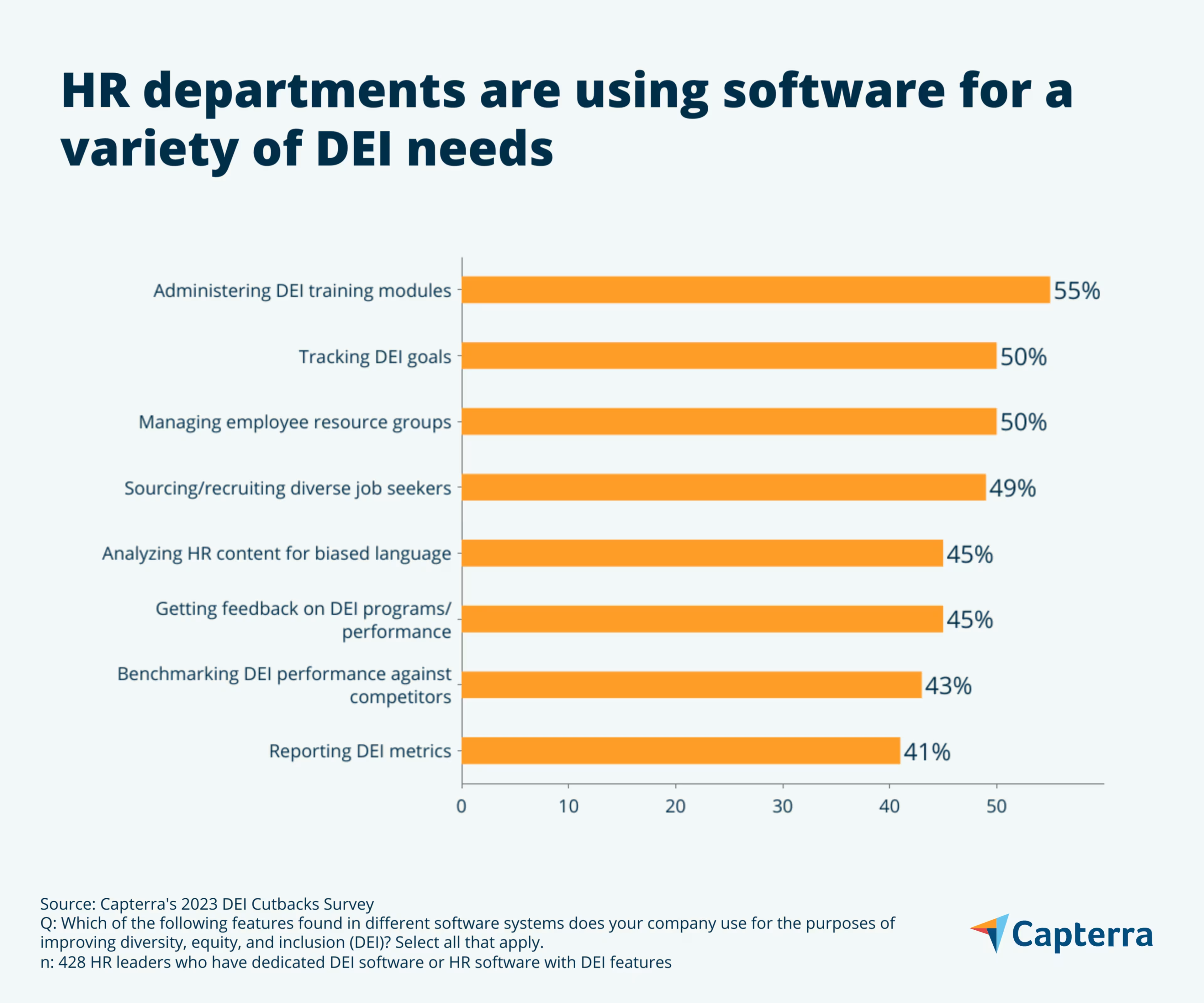
According to our data, these investments are already paying off. For five of the six DEI initiatives in our survey, the companies that invested significantly more money in them were more likely to say they expect to surpass their DEI goals for this year than those that only invested somewhat more money, the same amount of money, or less money.
Looking for DEI software for your own organization? Read reviews of top DEI tools here.
Here's how HR leaders can protect DEI programs in the future
Executive leaders are well aware of the business benefits DEI can bring at this point, and we've shown that they haven't been afraid to spend to improve DEI outcomes this year.
They also haven't had much reason to slash DEI budgets either. Outside of the sudden freefall at the outset of the COVID-19 pandemic, the rise of corporate DEI programs has coincided with an elongated prosperous period for the U.S. economy. Will companies still continue to invest in DEI when revenues trend downward and real cuts need to be made?
The HR leaders in our survey aren't confident that they will. Only 30% strongly agree that their company leadership recognizes DEI as a core pillar of their talent strategy that can't be sacrificed in tough times.
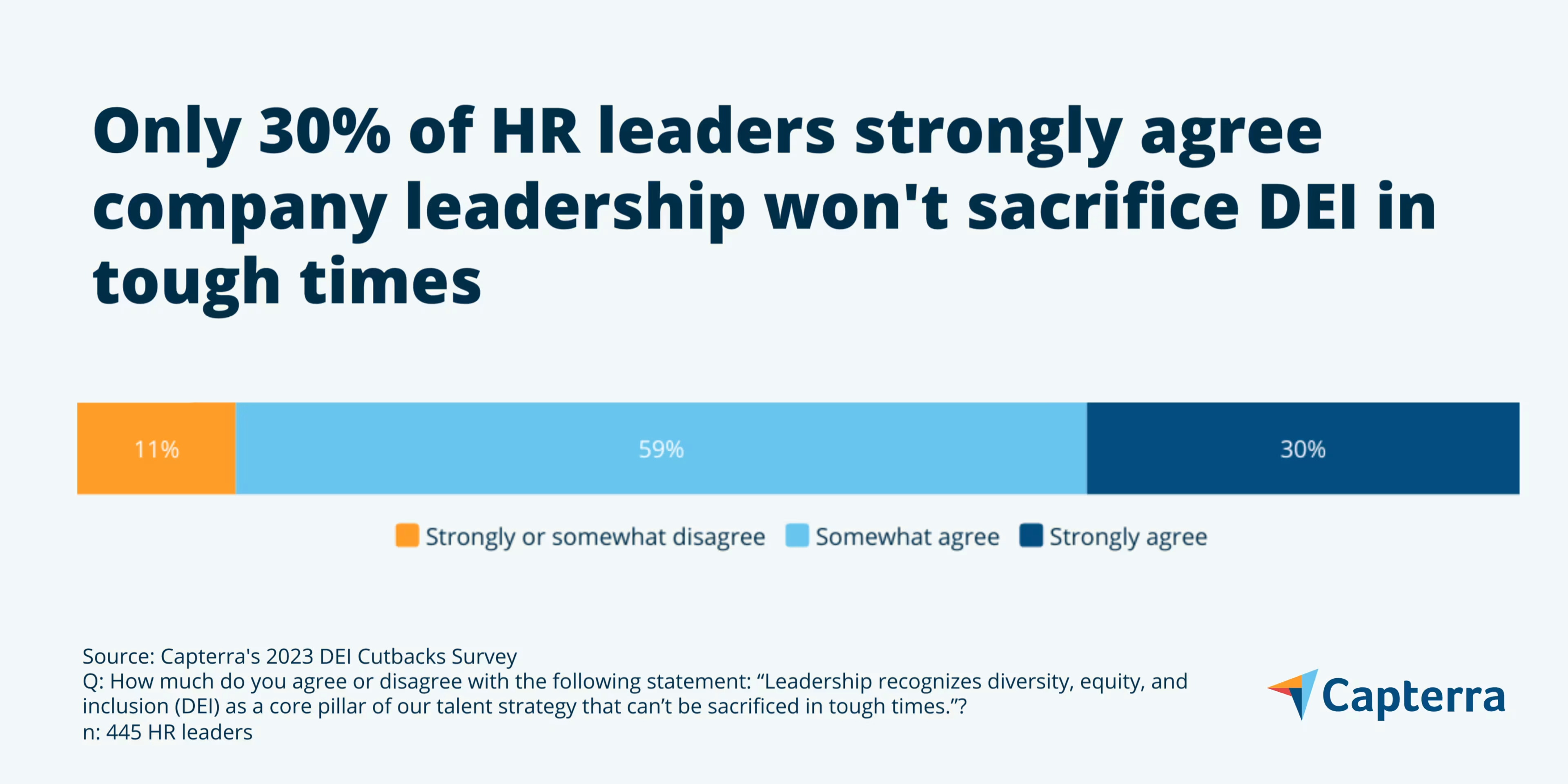
If you're an HR leader interested in protecting your DEI programs, this isn't the time to sit back and relax. Instead, your department should be working to convince executive leadership that your DEI initiatives are a necessary expense—even when spending cuts are unavoidable.
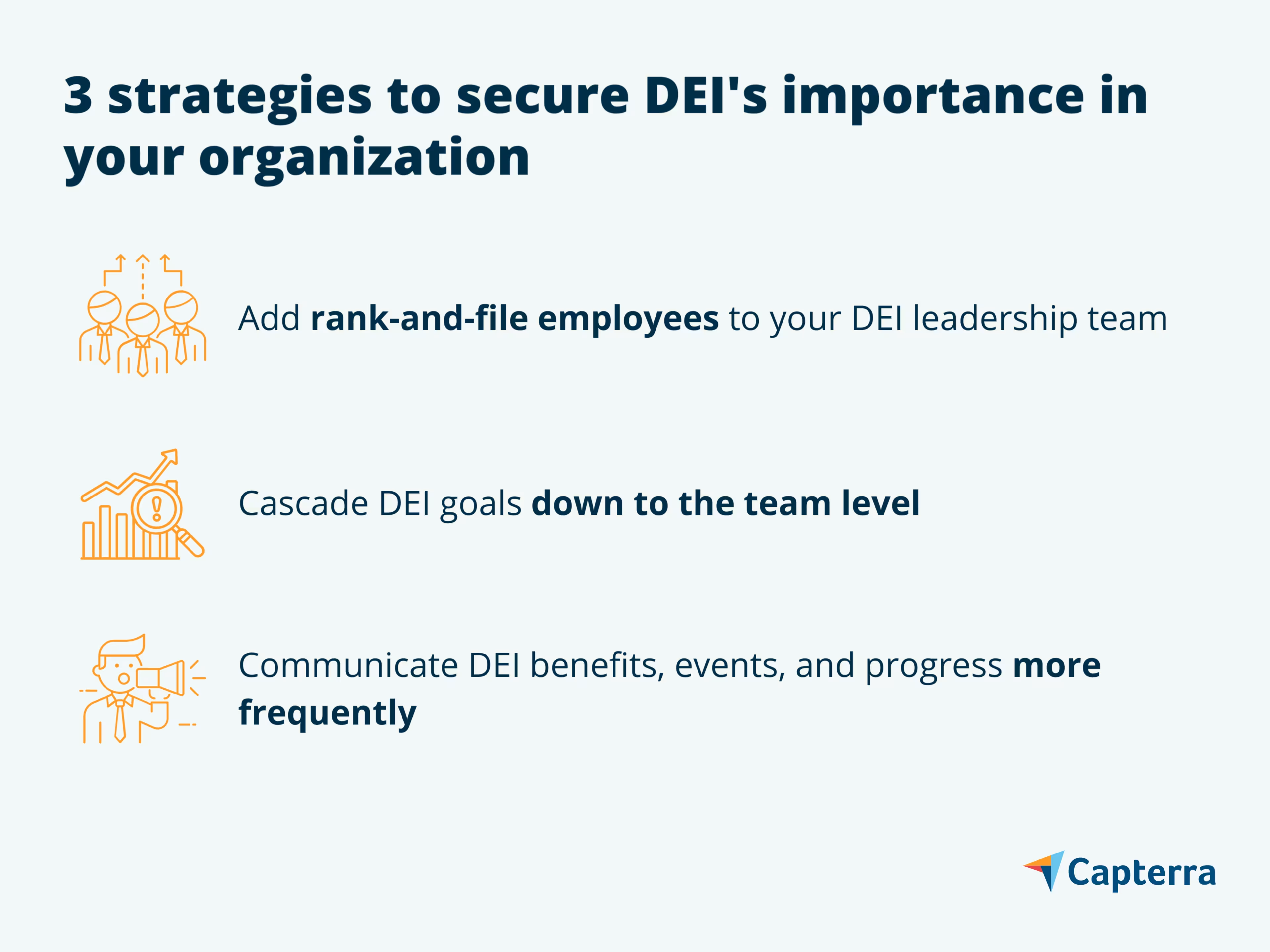
1. Add rank-and-file employees to your DEI leadership team
Gartner says if you want to build a sustainable DEI strategy, you have to leverage key voices across the organization and uncover drivers of exclusion "across diverse and underrepresented talent."[6] This can't be done if DEI strategy discussions are siloed to one team (like HR) or one level at the top, which is why it's critical to include staff-level employees from different departments on your DEI leadership team.
Not only will this create more employee ownership over DEI outcomes, but our data shows that folding in staff-level employees to help lead the DEI charge in your organization can help cement its importance. We find that DEI leadership teams that consist of executives and staff-level employees from different departments are more than twice as likely to strongly agree that company leadership won't sacrifice DEI in tough times compared to teams that just consist of executives (48% vs 22%).
2. Cascade DEI goals down to the team level
If DEI goals are only at the organizational level, it can distance individual teams and managers from feeling accountable towards them. This goal structure exacerbates the problem of leaders failing to take ownership for driving DEI outcomes, which a Gartner survey identified as the top challenge DEI leaders say they face.[6]
Even the smallest businesses (1 to 100 employees) should have team- or department-level DEI goals in addition to their overarching goals in order to put more pressure on managers to improve DEI—but we find that only 58% do (by contrast, 86% of large businesses with 1,001 employees or more have goals at this lower level).
Cascading DEI goals down to the team level can also better entrench DEI priorities throughout the company. We find that organizations with department-level DEI goals are 23% more likely to strongly agree that company leadership won't sacrifice DEI in tough times compared to those with goals just at the organizational level.
Once you've established your department goals, you should hold managers accountable to them by integrating DEI goals into their performance reviews. Gartner research finds that organizations that adopt this kind of "consequential accountability" will reach gender parity 13 years earlier and racial parity six years earlier in their leadership benches.[6]
3. Communicate DEI benefits, events, and progress more frequently
Keeping DEI top-of-mind for employees in your organization is just as important as actually making progress on DEI goals if you want your programs to be considered critical talent infrastructure. To that end, your team should be vigilant about sharing DEI events, employee benefits related to DEI, and news about DEI progress to the rest of the organization often through email, the company intranet, or a collaboration tool.
How often? Compared to only 22% of HR leaders whose companies share DEI communications to employees at least once a month, 53% of those who share DEI communications at least once a week strongly agree that company leadership won't sacrifice DEI in tough times.
Corporate DEI programs are safe… for now
Only time will tell how companies will respond when a deep recession takes place. That being said, DEI is still an emerging function in the grand scheme of talent management that needs safeguarding. DEI programs may be doing well for now, but by implementing these strategies, you can build a more compelling argument to executive decision-makers that DEI isn't just a feel-good initiative when times are good, but a critical component of having a productive and engaged workforce long-term.
If you liked this report, check out some of our other helpful DEI resources below:
